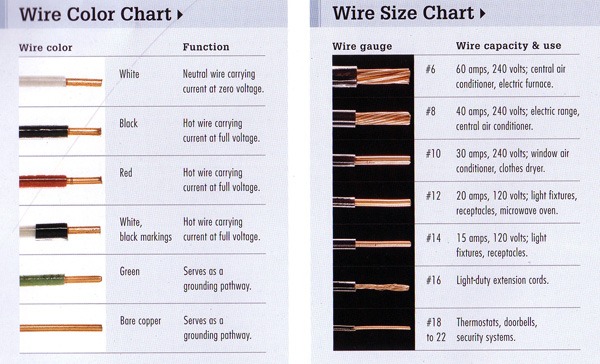
WIRE SIZE CHART INSTALL
When looking for the right wire thickness, first, we have to define the circuit's maximum current and, using the wire's Ampacity, find the proper wire thickness at the required temperatures.For every electrical need in your house, it is essential to install cables that pass an electrical inspection. Also, the actual Ampacity (80% of theoretical Ampacity) of wires suspended in the air was taken into account. Note: for the values that were very close, the thicker wire was chosen. Note: since cables generally have two wires, if You need a cable that is 10 feet long, calculate the total resistance for 20 feet long wire.Īmerican Wire Gauge (#AWG) Copper Wires Suspended In Air Where I(A) is the maximum current through the wire. Thus, the total resistance of the wire can be calculated as follows: The standard acceptable voltage drop in 12V circuits is 3%, which is 0.36 volts. Too thick wires can be used, but thick wires are more difficult to work with (even when stranded wires are used), they are heavier and more expensive. To transfer energy efficiently, wires must be thick enough to keep energy losses to a minimum. 90☌ (194☏): FEP, FEPB, MI, RHH, RHW-2, SA, SIS, TBS, THHN, THHW, THW-2, THWN-2, USE-2, XHH, XHHW, XHHW-2, ZW-2.ġ2V voltage is the standard voltage used in cars, trucks, boats, campers, etc., and is equivalent to the nominal voltage of a 6-cell lead-acid battery.Thus, use these values as such, but when in doubt, always go for thicker wires and keep them protected from the sun and similar heat sources. However, wires suspended freely in the air can also be heated by, for example, the sun. This cooling effect can be even increased when, for example, powering an electric trolling motor and a gentle breeze sweeps across the lake, river, or sea surface. Wires, cables, and conductors, in general, have higher ampacities when suspended in air due to better cooling. Note: stranded copper wires have a diameter 5-7% larger to compensate for gaps between the wire strands and must be checked for each wire. Insulated Solid Aluminum Wire Ampacity kcmil Wire The following chart lists solid insulated copper wire Ampacities for wire areas given in kcmil and mm2 and wire diameters given in mm2 and inch2. from 1000 to 2000 in increments of 250 kcmil.from 400 to 1000 in increments of 100 kcmil,.from 250 to 400 in increments of 50 kcmil,.

In Canada and the United States, circular mils (cmil) are used to define wire sizes larger than 0000 AWG (4/0 AWG), starting with 250000 cmil, which is written as 250 kcmil or 250 MCM - 250 thousand circular mil. mm 2Ī circular mil equals the area of a circle with a diameter of one-thousandth of an inch (one mil) or 0.0254 mm and it has a value of 5.067075×10 −4 mm 2 (506.7075 μm 2). Personally, wires thinner than AWG20 are too thin to be used in anything except special electric and electronic projects. Note: Ampacities are given for enclosed wires ambient temperatures. Note: the great thing about Ampacity is that it has the same value, regardless of the voltage applied - generally, it "just" depends on the wire thickness, wire material, and quality of insulation (allowed maximum temperature).Īnd here is the Ampacity chart of enclosed copper wires:

Ampacity of the wires is given in Amps - Ampacity is the current-carrying capacity of the wires and is s usually defined as the maximum current that a wire can carry continuously under the conditions of use without exceeding its temperature rating. Area in 2: cross-section area of the cable, given in inch 2. Area mm 2: cross-section area of the cable, given in mm 2. Diameter inches: diameter of the cable, given in inches. So, if you need, for example, AWG 5 cable, but you are offered cables in millimeters only, you should buy a cable 4.62 mm in diameter (with a 16.77 mm 2 cross-section area) or next thicker cable. Diameter mm: diameter of the cable, given in millimeters. AWG #: American Wire Gauge cable thickness Keep in mind that metal resistance increases with temperature, not by much, but if you can't hold your trolling motor cables in your hands due to the heat, decrease the power and get thicker cables as soon as possible. Other materials can be used as well, but most of the time, wires are made out of these materials. Some of the most commonly used materials for wires are copper, with a resistivity of pure copper of 16.78 nΩm at 20☌ and aluminum, with a resistivity of pure aluminum of 26.5 nΩm at 20☌.
WIRE SIZE CHART HOW TO
With various standards around, it is important to know how to convert proper cable sizes from one standard to another.Īlso, voltage drop and power losses depend on the cable length, thickness, and current flowing through the cable. Wire Gauge Charts: AWG to mm2 Conversion Charts and Wire Sizes


 0 kommentar(er)
0 kommentar(er)
